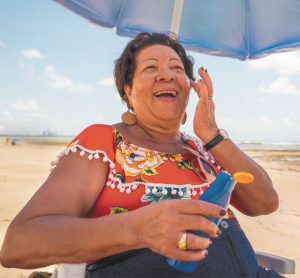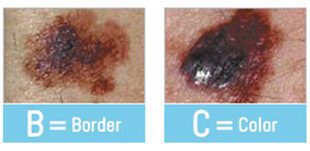

The amount of UV radiation from the sun that hits the Earth’s surface can impact your health. Increased UV exposure can cause more than pain, UV damage can be long term. Prolonged exposure can cause skin cancers, cataracts, and immune system damage. The sun’s UV rays cause damage to your epidermal cells. Your body will try to counter this by increasing blood flow to the area where the cells are being damaged. While your body is trying to get rid of the damaged cells, you may also experience an itch around the area. These symptoms get worse over the year as older individuals are affected quicker making their appearance even more aged. Simply stated, it is best to protect your skin from the sun’s UV rays.
Small amounts of ultraviolet (UV) radiation are essential to produce vitamin D in people, yet overexposure to sunlight may result in acute and chronic health effects on the skin, eye, and immune system. The rise in the incidence of skin cancers over the past decades is strongly related to increasingly popular outdoor activities and recreational exposure. Experts believe that 4 out of 5 cases of skin cancer could be prevented through protecting against overexposure to sunlight.
According to a study published in the British Journal of Dermatology, consuming alcoholic beverages on a regular basis increases the risk of developing melanoma, a dangerous form of skin cancer, by up to 55 percent. Having more than one drink per day (considered heavy drinking) increases your risk for melanoma by 20 percent, and drinking poolside only increases your risk.
Ethanol, the form of alcohol found in alcoholic beverages, metabolizes in your body turning into a compound called acetaldehyde. Acetaldehyde heightens the skin’s sensitivity to UV rays, increasing the likelihood for cell damage and cancer. Sipping margaritas at the beach just turned into a bad idea.
Can wearing more clothing keep you cool and prevent sun damage? Getting a sunburn is never fun, but there are plenty of ways to prevent sunburn. Rash guard clothing provides a physical barrier from the sun and comes with the added benefit of having UPF protection built into the fabric. Unlike wetsuits, rash guards are not meant to keep your body warm. They are not as thick as wetsuits, so they do not trap body heat as well. They can have a cooling effect on the body because of their material and how tight they lay on your skin.
Since the purpose of rash guard shirts is to prevent rashes and protect you from the sun, they are generally made of athletic fabrics like polyester, nylon, lycra, and spandex. These materials are soft, durable, and lightweight while allowing for breathability and stretch to maximize your comfort. Add a UV blocking hat to maximum sun protection. If you work outdoors, clothing that keeps you cool, and blocks UV rays is a must.
Chemical sun protection involves sun blocks and sunscreens applied to the skin. Sun block prevents UV radiation from penetrating your skin by creating a chemical barrier that reflects UV rays. Zinc oxide and titanium dioxide are two of the most common minerals that provide sun block protection, and these ingredients are more commonly being incorporated into mineral makeup to provide some SPF protection.
Sunscreen limits the oxidative damage UV radiation can wreak on skin cells and components of the extracellular matrix by trapping UV radiation at the skin’s surface and neutralizing free radicals. To provide effective sun protection, chemical blocks and screens must be applied in adequate amounts approximately an ounce (golf ball-sized amount) to cover exposed parts of your body. You must also get sunblock/sunscreen that provides an adequate level of protection, meaning SPF 15 or higher.
Melanoma and skin cancer prevention should not make you afraid to get out and enjoy the sunshine. Hiding from the sun can result in or exacerbate a vitamin D deficiency, which comes with a host of adverse health effects all its own. The key is to responsibly enjoy your sunshine. When you know you’re going to be outside, seek shade cover up, and apply and re-apply sunblock/sunscreen liberally.
If you didn’t adequately protect yourself and you’re left red and raw, treat your sunburn, and nourish sun-damaged skin with an antioxidant-rich moisturizer. You can always eat your sun protection, too. Dark, colorful foods are rich in phytonutrients that protect plants from UV radiation, and they deliver antioxidants that can help your body do the same. If you discover any suspicious-looking spots on your skin, see your healthcare provider. Early detection leads to the best prognosis for melanoma and skin cancer.
At IntuneHealth we provide proactive, preventive care designed to keep you healthy. With virtual, in-office, and in-home appointments, access to care is conveniently available when and where you need it. IntuneHealth takes the hassle out of health care giving you direct access to your primary care physician, a personal care team coordinating all aspects of your care, and an all-in-one app to manage your health. Schedule an appointment today to meet your new partner in health.
Intune Health
A new approach to primary care for
those with a Medicare Advantage plan.
(239) 790-1122 | IntuneHealth.com
References:
Rota, M., Pasquali, E., Bellocco, R., Bagnardi, V., Scotti, L., Islami, F., Negri, E., Boffetta, P., Pelucchi, C., Corrao, G. and La Vecchia, C. (2014), Alcohol drinking and cutaneous melanoma risk: a systematic review and dose–risk meta-analysis. Br J Dermatol, 170: 1021-1028.
https://doi.org/10.1111/bjd.12856
 Southwest Florida's Health and Wellness Magazine Health and Wellness Articles
Southwest Florida's Health and Wellness Magazine Health and Wellness Articles

